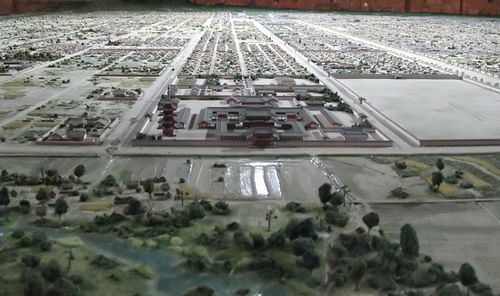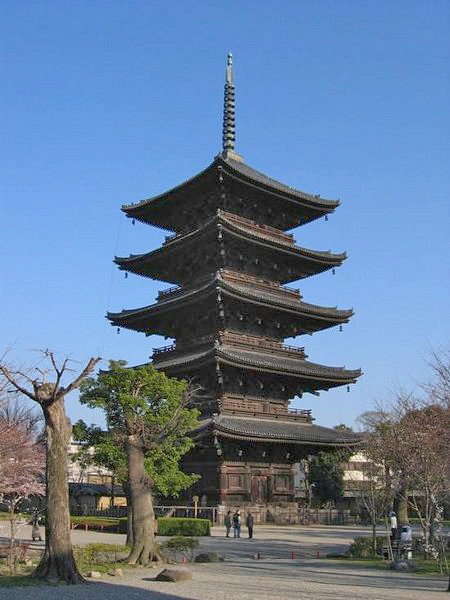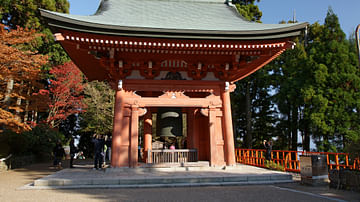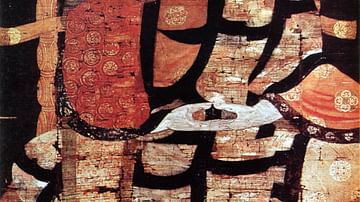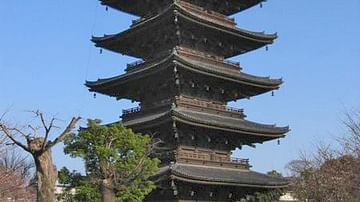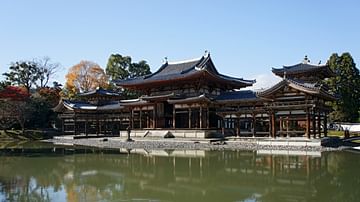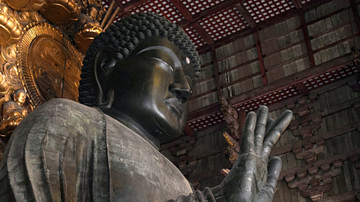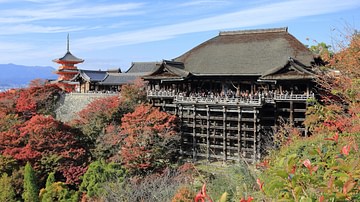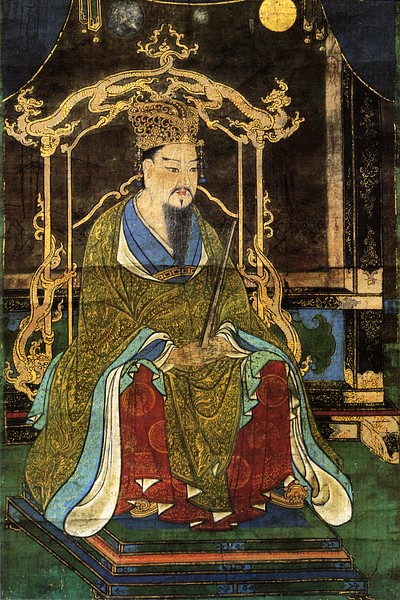
Emperor Kammu (aka Kanmu) reigned in ancient Japan from 781 to 806 CE and is most noted for relocating the capital to Heiankyo (Kyoto) in 794 CE. Kammu was one of the most powerful emperors Japan had seen or would ever see, and his reign witnessed a restructuring of the royal household and government, reducing the state's costs and making it better able to manage the country and fight corruption.
Crown Prince
Kammu was born in 737 CE, his father was Emperor Konin (r. 770-781 CE) and his mother a Korean commoner. Initially removed from the line of succession, a common practice in the large families of emperors, he was later reinstated thanks to his supporters in the powerful Fujiwara clan which dominated most of the important positions of government and the imperial court. In 773 CE Kammu was officially selected as his father's successor, no doubt helped by his influential uncle Fujiwara no Momokawa. In 781 CE Emperor Konin abdicated, and his son Kammu was made emperor. Kammu, as was the tradition, gave his reign an era name or nengo. His choice was Enryaku, meaning 'prolonged succession,' which would prove apt for his 25-year reign.
From Nara to Heiankyo
During the Nara Period (710-794 CE) the Japanese imperial court was beset by internal conflicts motivated by the aristocracy battling each other for favours and positions, and an excessive influence on policy from the Buddhist sects whose temples were dotted around the capital. There was also a failed plot to seize power in 782 CE by descendants of Emperor Temmu, who had been displaced when Konin had taken the throne.
Eventually, the situation resulted in Emperor Kammu moving the capital from Nara to Nagaokakyo on the Yodo River in 784 CE. The new site did not last long, though, after the assassination in the palace of one of Kammu's chief advisors (Fujiwara no Tanetsugu), the untimely death of one of Kammu's wives and a son, a severe flood and an epidemic, which all gave Nagaokakyo an air of bad luck. Indeed, the ringleader of the assassination plot, Prince Sawara, Kammu's younger brother, was exiled, but he died of self-inflicted starvation and it was thought that his bad spirit or kami was responsible for the disasters. It was, thus, decided to relocate again, this time to Heiankyo in 794 CE. This move marked the beginning of the Heian Period which would last into the 12th century CE, and Heiankyo, or Kyoto as it became known, would remain the capital of Japan for another thousand years.
Heiankyo, meaning 'the capital of peace and tranquillity,' was laid out on a regular grid plan along Chinese models. The aristocracy had fine palaces with their own carefully landscaped gardens and a large pleasure park was built south of the royal palace (Daidairi). No Buddhist temples were permitted in the central part of the city and no clergy were permitted to relocate from Nara, although, Kammu did permit the construction of two temples either side of the city's Rashomon gate: the Sai-ji (West Temple) and To-ji (East Temple). The latter was expanded by the famous monk and founder of Shingon Buddhism Kukai in 823 CE and was given its splendid pagoda, Japan's largest, in 826 CE. Kammu did not neglect the Shinto religion either and built the important Hirano Jinja shrine in 794 CE. The capital, with its wide avenues and artisan quarters for artists, metalworkers and potters, became one of the great cities of East Asia.
Government
Emperor Kammu continued to apply Chinese principles to government, especially Confucianism and Taoist interpretation of omens. However, he did prune the state administration which had become unwieldy and too costly. The number of civil servants was curtailed and some ministries suppressed. Kammu also formed a small body of counsellors to act as an advisory body, the household treasury office (kurando-dokoro). In these reforms, Kammu was aided by the fortunate timing that saw most of the old powerful clan leaders pass away and their successors struggle to find the resources to relocate twice to the new capitals.
The bloated royal court was similarly trimmed in 805 CE in a process known as 'dynastic shedding' with over 100 princes and princesses reduced from royal to noble status and given clan names such as Minamoto, Taira and Ariwara. At the same time loyal followers were given generous land grants or key government positions (many were simply left vacant too) so that the emperor was able to sweep away the clutter of previous regimes and set himself up as the supreme and all-powerful sovereign surrounded by his supporters who owed their position and status directly to him.
Although Kammu was wary of the influence of the Buddhist sects on politics, he did permit the continued state sponsorship of Buddhist temples and allowed Buddhist monks to represent their sects at state ceremonies and festivals. In 785 CE, the emperor further strengthened his independence from religion by insisting that the imperial court nominate abbots of temple sites (notably Enryakuji on Mount Hiei) and passing a law which restricted the freedom of monks outside monasteries. The Buddhist sects were further monitored in 799 CE by instructions for regional governors to register all monks and practitioners. More edicts followed, which were all aimed at rooting out monks who abused their position, practised magic against their enemies, fathered children, made loans to peasants at excessive rates of interest and so on. Kammu was himself a follower of Buddhism and his policies were aimed at cleaning up the religion rather than repressing it.
Another important policy change instigated by Kammu was the ending of conscription of peasants into the militia of the provinces. Farmers had not proved to be very effective warriors, and when not involved in actual combat, they had been abused by local commanders who pressed them into labour service for their own ends. The state now paid professional warriors, but their necessity was rare, being employed only in occasional expeditions against pirates and in border skirmishes with the Emishi tribes in the north of Japan. The Emishi had finally been subdued after decades of indecisive battles following major expeditions in 794 CE and 801 CE led by the two seii taishogun Otomo no Otomaro and Sakanoue no Tamuramaro respectively. In the latter campaign, a fort was built at Isawa to ensure there were no further hostilities.
One consequence of the policy to end conscription was that large estate owners began to form their own private armies of samurai to protect their interests, and these would eventually give certain clans such as the Taira and Minamoto the means to try and grab political power for themselves. To fill the gap left by the downgrading of the army the police force was given greater powers, which included a judicial function, and a small force of armed youths (kondei) was created to guard government property in the provinces.
Attempts were made to reduce corruption in the provinces where administrators were left to their own devices to extract taxes in kind. A body was established called the kageyushi which helped ensure tax records were maintained and an audit made whenever there was a transfer of governor. Still, the long-term effect of having local strongmen backed by their own private army and syphoning off state taxes was a gradual reduction in the economic power of the central government. By the end of the Heian Period in the 12th century CE, these warlords would seize political power for themselves and keep it for six centuries.
Death & Deification
Kammu died in 806 CE, and he was succeeded by his sons Emperor Heizei (r. 806-809 CE), Emperor Saga (r. 809-823 CE), and Emperor Junna (823-833 CE). Despite this dynastic continuity Kammu's reign was a watershed for Japanese government, and his successors would have to battle with powerful clans who sought to ever reduce the power of the emperor, as the historian W.H.McCullough summarises,
Kammu was the last of a line of puissant, capital-building monarchs who were able to mobilize the entire country's wealth and military power for national or dynastic purposes. After him, the limelight of central political history shifted steadily and rapidly away from the person of the sovereign toward erstwhile holders of nominally subordinate court posts…[by 850 CE] the Fujiwara clan was well on its way to complete domination of both the emperor and the organs of his statutory government. (Whitney Hall, 25)
Emperor Kammu was enshrined as the deity or kami spirit of the Heian Jingu shrine in Kyoto, founded in 1895 CE on the 1,100th anniversary of the city's foundation as the capital of Japan.
This content was made possible with generous support from the Great Britain Sasakawa Foundation.
